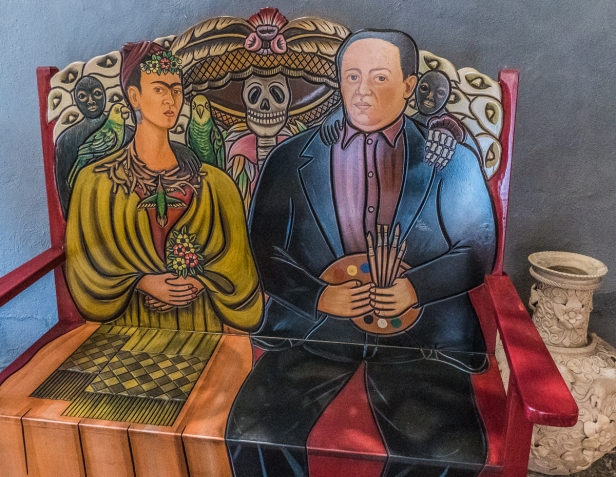
22 Dec 2016 – 3 Jan 2017. We’re waiting on the sidewalk. We can see the doorbell but don’t ring it knowing it’s not yet ten o’clock. There’s another couple also waiting. They ring the bell. To our surprise the door is opened immediately and we’re invited inside. I find myself in a place of jaw-dropping joy-rising splendor. We are in the large front foyer of a very large house, and I hardly know where to look first. The room is crammed with dozens of pieces of Mexican folk art, each one singing with the whimsy and playfulness of creativity. But don’t be mistaken, within each traditional piece, passed on through the generations, there is a potent spiritual significance.
There’s a papier-mâché deer strung from the ceiling. The wooden frame on the deer’s back is loaded with fireworks. The deer would be held high over the head in a ritual dance while the fireworks exploded with thunderous brilliance.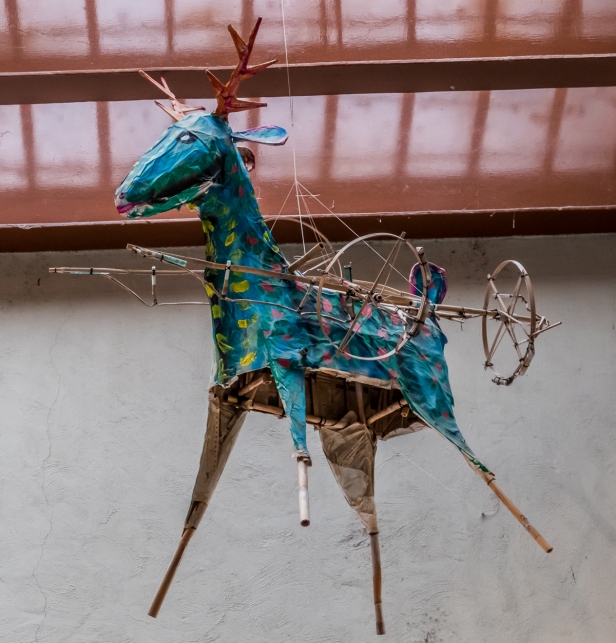
There’s a papier-mâché clown also with fireworks attached. There’s a life size wooden skeleton in a blue skirt and a deer head attached to the top of its skull, and next to it a huge delicate ceramic platter on a pedestal. There’s a floor to ceiling ceramic piece depicting village life, and a bench of Frida and Diego. There’s a second wooden skeleton holding a spear sticking into the skeleton of a deer, and paintings, and ceramics, and carvings, filling every space. And this is just the beginning.
In the year 2000, after many visits to Mexico and a lot of searching, John and Dorianne Venator from Chicago purchased a property in the city of Valladolid, Yucatán. It was a crumbling Spanish Colonial hacienda that had not been occupied since 1964. To call it a fixer-upper was an understatement: renovation and remodeling took nine years.
Now behind the austere walls that face the street half a block from the zocalo, or town square, is an exquisitely restored 18,000 square foot palatial mansion: a private home, and a museum housing the largest collection of museum-quality Mexican folk art in private hands. It is known as Casa de los Venados – House of the Deer.
The couple has been passionate collectors of Mexican folk art for over thirty-five years and their collection now includes more than 3000 pieces, most acquired directly from the artists.
Several years ago a friend pointed out to John that he’d given seven private tours during the previous three days and suggested he make a business of it. The Venators had no desire to start a business but were happy to make their collection available to the public. So now every day at 10am they open their doors to visitors to tour their home and view this extraordinary collection. Tours by professional guides are in English and Spanish, and last about an hour. John himself sits in the courtyard greeting visitors. There is no charge. Visitors are asked for a donation and all monies collected go to local charities.
What a place! We enter into the spacious entrance hall, then on into a couple of reception rooms leading to a beautiful open courtyard.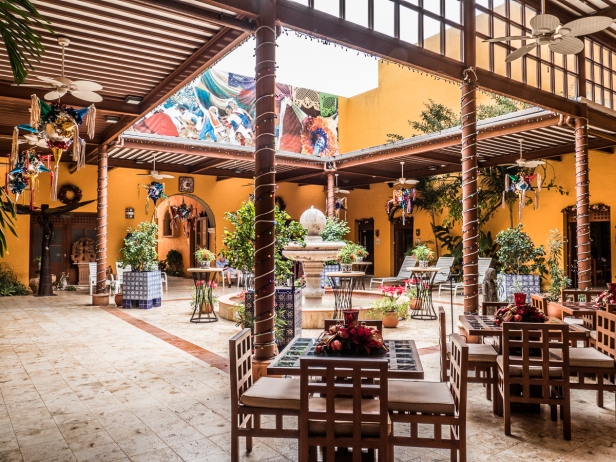
There are four self-contained guest suites each with living room, bedroom, bathroom, and small private garden.
Deeper into the space is another wide-open courtyard, which is entered by a bridge over a grand infinity pool bordered by a covered barbeque area. Beyond this is the suite of rooms where John and Dorianne live day to day, and we are shown the kitchen, dining room and living room.


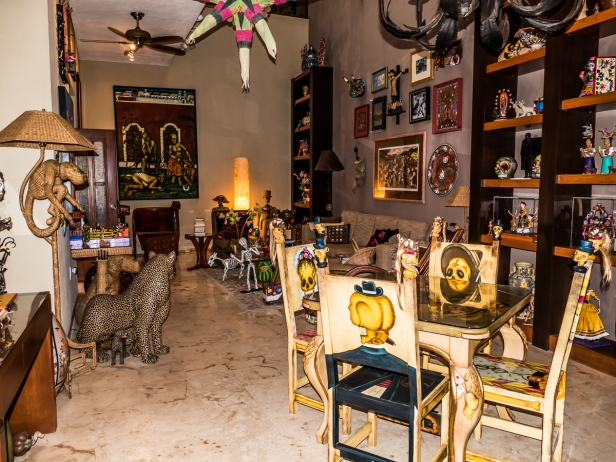
All the while the guide points out some of the more significant pieces. We hear where each came from, how it was made, and how the Venators acquired it. There is everything from ceramics to metalware to woodcarvings, papier-mâché, mirrors, hats, tile work, bead work, and piñatas made from hundreds of tiny scrunched pieces of crepe paper individually glued on.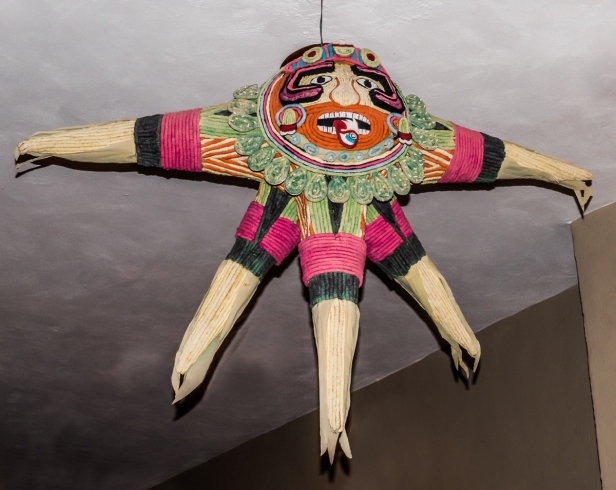
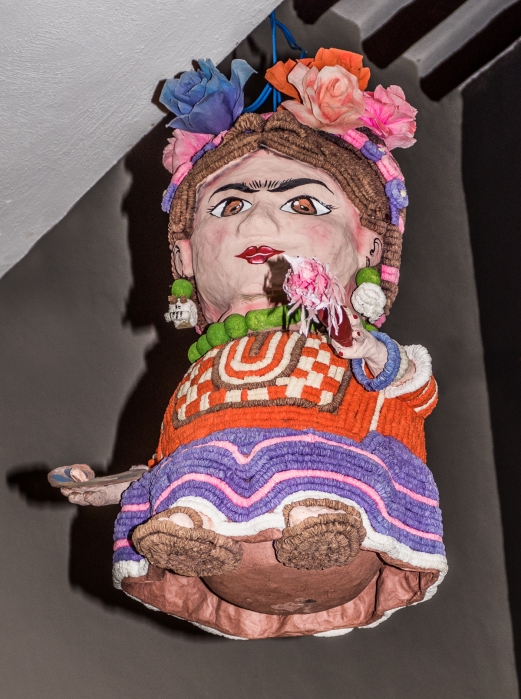
There is so much, and so much variety, it’s hard to know where to look, how to take it all in. It is a visual feast that astonishes again and again with every turn of the head.
Here’s a small selection of what we saw:
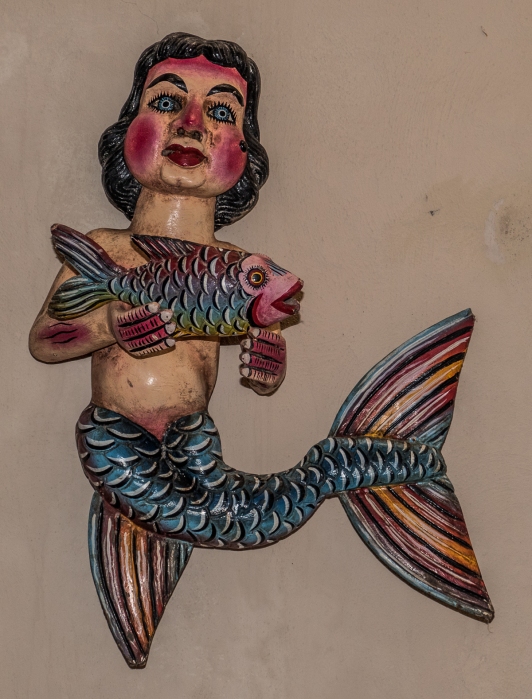
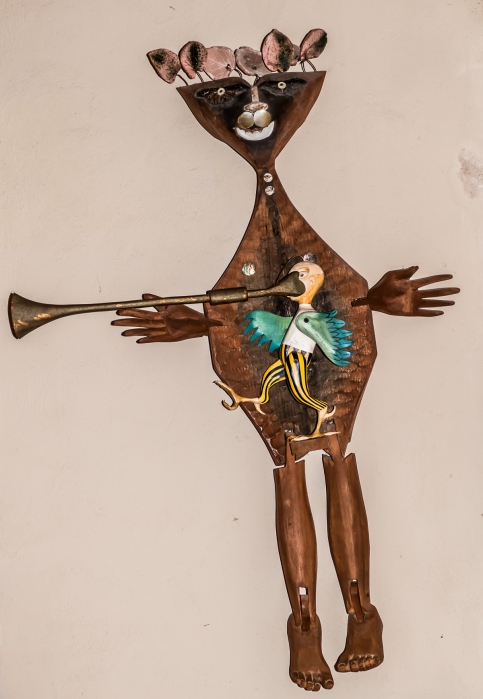


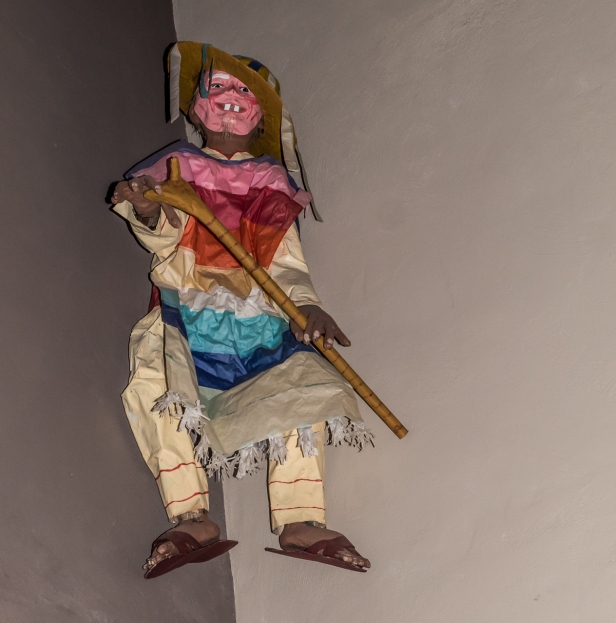
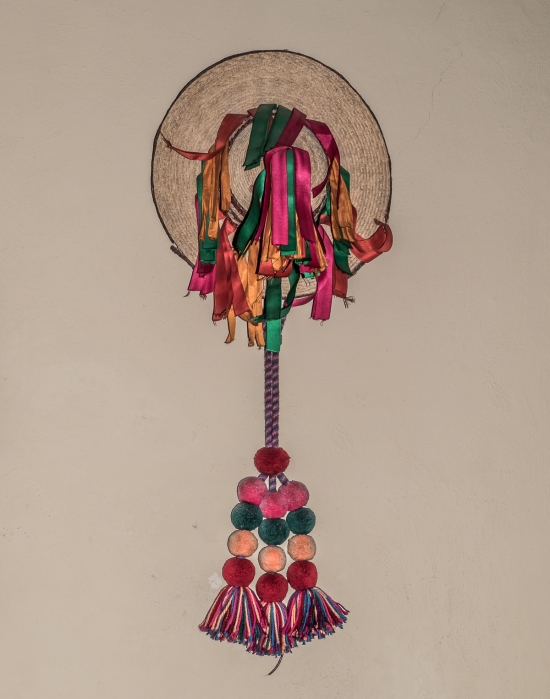
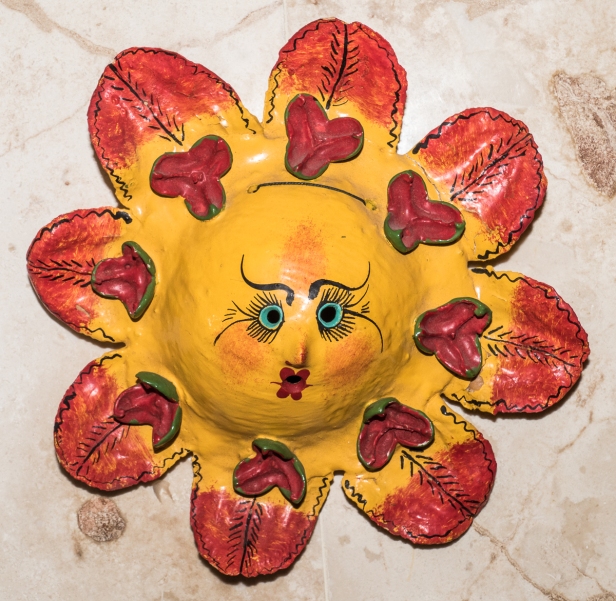



***********************************
In pronounced contrast to the beauty of the folk art created by people, there is a mysterious underground world in the Yucatan created by nature. This underground realm is vast and deep, with caves and cathedrals, narrow dark passageways, long rivers, and bottomless pools. To this day it has not been fully explored.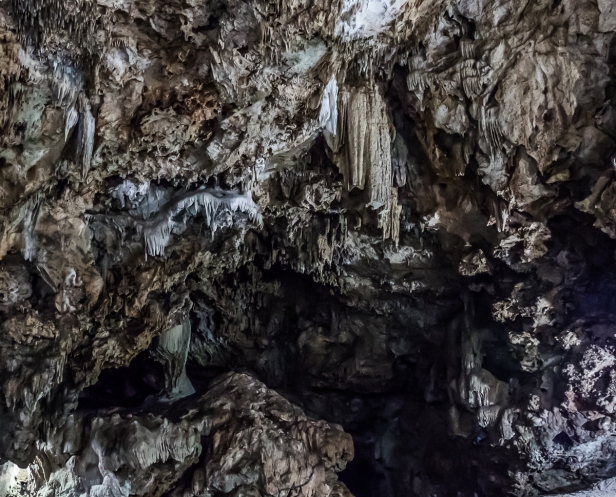
The shaft of sunlight cuts through the darkness illuminating a magical blue world singing with secret depths. Having descended a short flight of stairs we are on a natural balcony looking down into what was once a hidden cave, a huge hollow cathedral within the earth. A few thousand years ago the limestone ceiling of the cave, weathered by wind and water, gave way, creating a small hole in the ceiling. At the bottom of the cave is a pool of sparkling sapphire water several metres deep. The walls of the cave drip with limestone formations.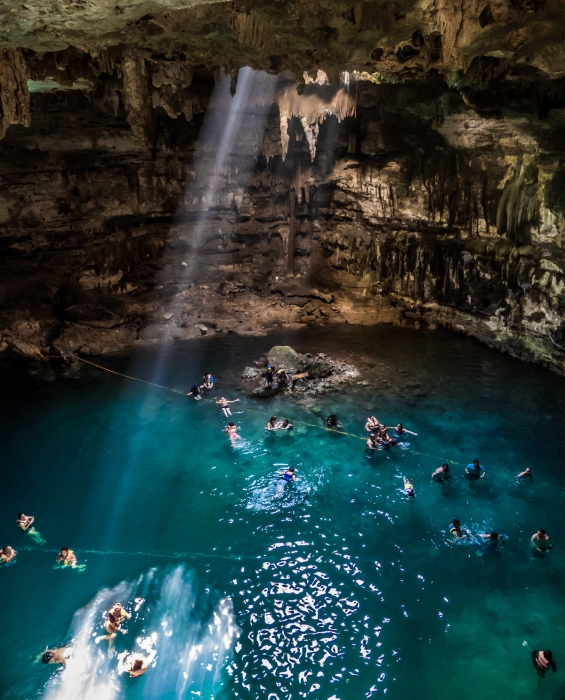

Just seven kilometres from Valladolid near the small town of Dzitnup, today Cenote Samula is no longer a secret. It is a popular swimming hole, and the perfect place to cool off in Yucatan’s muggy heat. We climb down to the waters edge. Small catfish swim by,
and bats fly high above.
The Yucatan Peninsula is home to the longest underground river and cave system in the world. One of the rivers is 153 kilometres (95 mi) long. There are an estimated 6000 cenotes (say-no-tays), or sinkholes, though less than half of them have been explored. They are formed when the flat porous limestone shelf of the peninsula gives way and falls into the cave system below creating an opening into the underground world. The underground rivers and the pools at the bottom of the sinkholes are the peninsula’s only sources of fresh water.
The stone pathway that connects Cenote Samula to nearby Cenote Xkeken is sprinkled with replicas of ancient Mayan designs.
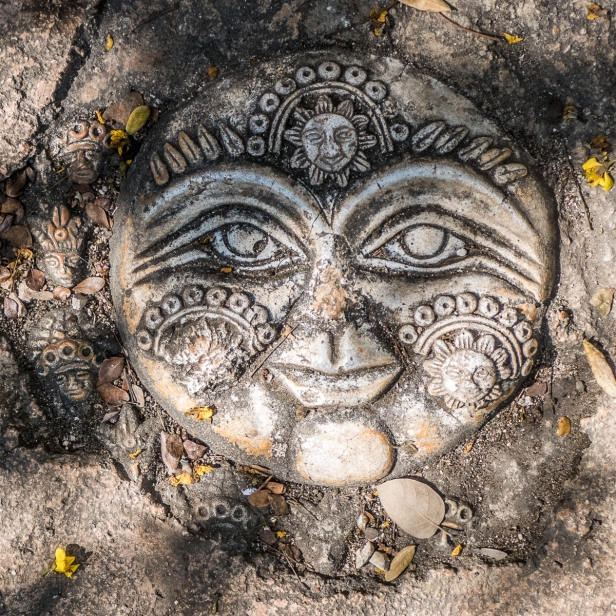
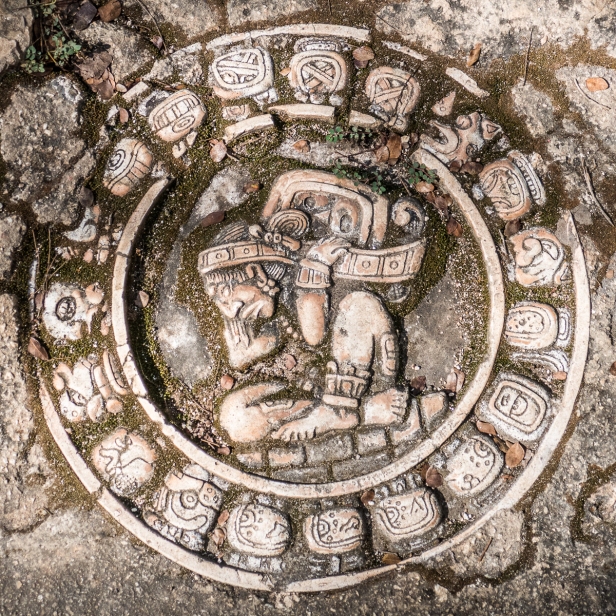
After passing quickly through a large circular concrete hutch of artisan stalls we enter the cool world of Cenote Xkeken down a narrow passageway deep into the earth.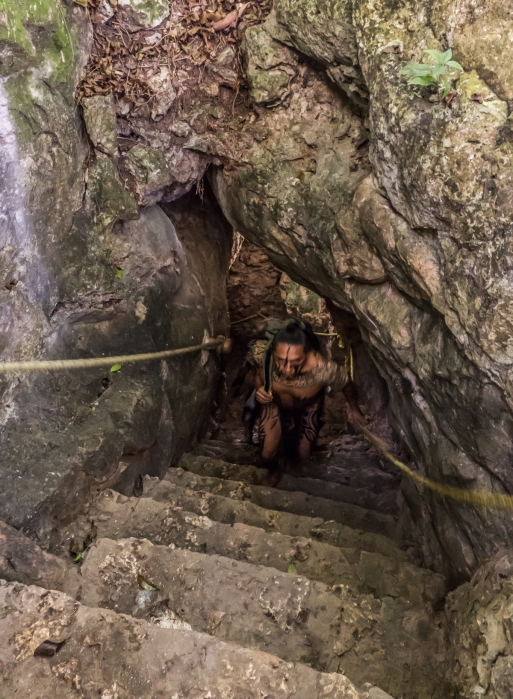
The hole in the ceiling of Cenote Xkeken is smaller even than that of Cenote Samula, and artificial lighting is needed. We have entered deep into the underground, into what once was a mysterious dark place humming with the song of the earth. Fat stalactites almost reach the water, bats fly above, and the roots of trees reach all the way down to the water, long strings caught in the limited sunlight.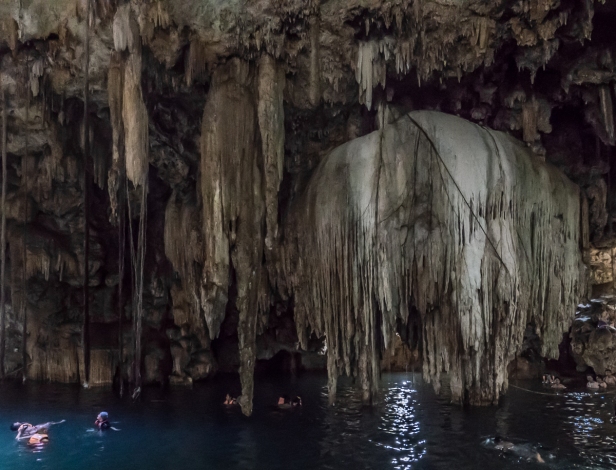

We join the crowd and swim here. The water is cool and delicious. I want to go exploring deeper into the cave but it is roped off and there is a stoic guard sitting nearby.
Mayan hieroglyphics define cenotes as “abysmal and deep”, and the Mayans believed them to be entrances to the underworld. They would visit cenotes to communicate with their ancestors and gods, including Chaak, their rain god. Cenotes were sacred places where spiritual ceremonies were held and sacrifices made, including human sacrifice. The only light available to them would have been flaming torches. In the sporadic flickering firelight the caverns must have seemed impenetrable, and eerie; potent enigmatic places where spirits dwelt, and where anything could happen.
About three blocks from the central square in Valladolid is Cenote Zaci. There is no ceiling to this cenote. The top is completely open forming cathedral walls covered with moist green ferns and giant tropical vines. Three small waterfalls cascade from above in a steady soft rhythm. The cool blue water is eighty-five metres deep.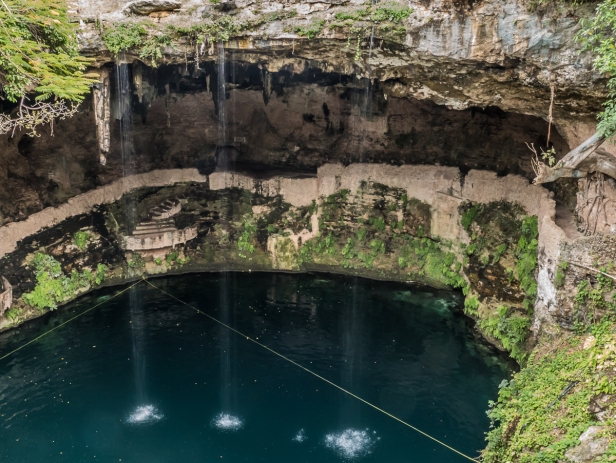
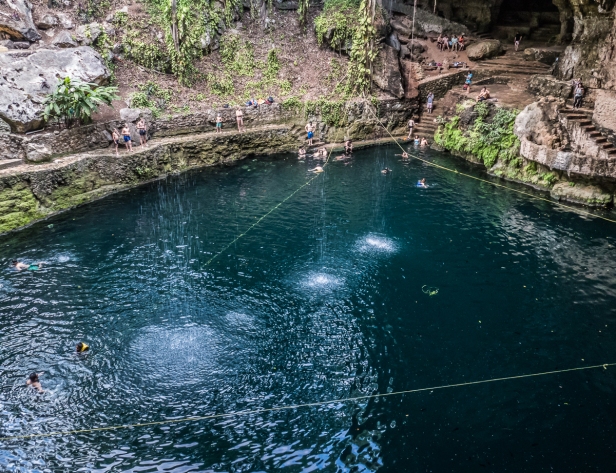
After an early morning visit to the spectacular Mayan ruins of Chichen Itza we take a taxi to Cenote Ik Kil, just five kilometres away. Like Zaci, the top of Ik Kil is wide open. The walls are a cascade of tropical plants, and long streamers of thirsty tree roots reach for the water through the lush green ferns and vines. Despite the signs, in English and Spanish, admonishing people not to touch the tree roots, and warning that you swim at your own risk; despite the concrete stairs, and the crowds of people, it is a magical place.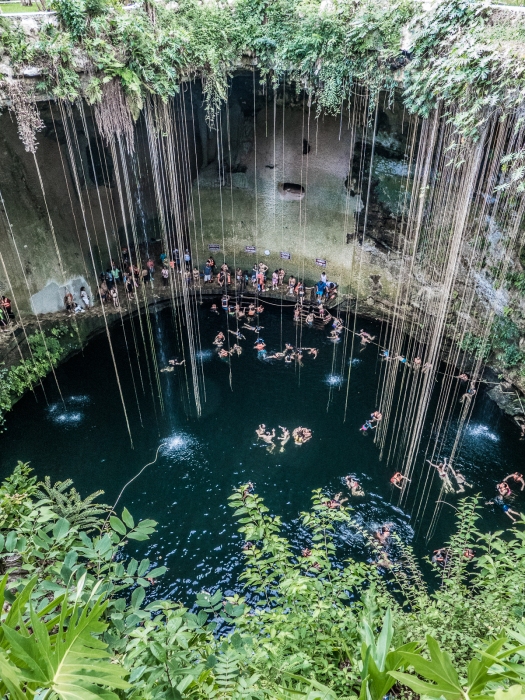
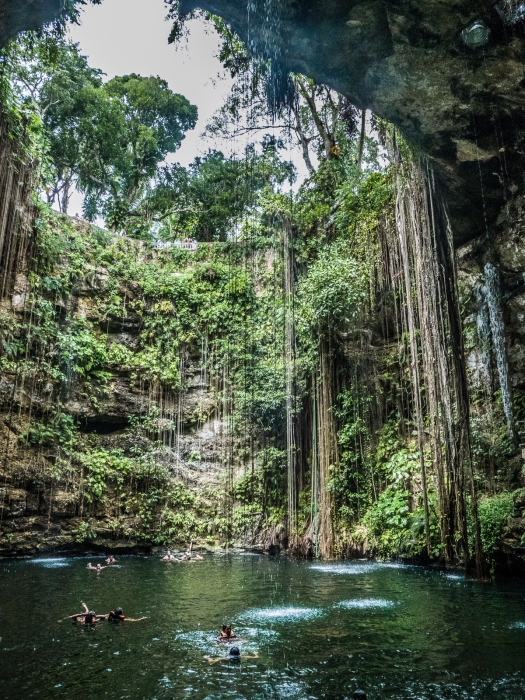
After a swim and a rest we walk back out to the highway and wait by the side of the road. Within about ten minutes a colectivo, one of many vans that travel the road between Valladolid and Chichen Itza, stops and takes us back to town.
We also visited Cenote Eden, near Playa del Carmen.
During our time in the Yucatan we visit four of the thousands of ruins left from the thousands of years of Mayan civilization: Ek Balam, Chichen Itza, Edzna, and Palenque in the next post.
All words and images by Alison Louise Armstrong unless otherwise noted
© Alison Louise Armstrong and Adventures in Wonderland – a pilgrimage of the heart, 2010-2017.

Beautiful! I love the tile work, the colors, the inner courtyards, the exuberance, and the joy! I have a hacienda home, with lots of tile work and an inner courtyard, and lots of Mexican art, and this is why! The roots in the cave are awesome!
LikeLiked by 1 person
Thanks Cindy. I love Mexican folk art – the colour and honesty and exuberance. I can see you living in a place like this!
Aren’t those tree roots amazing. Down and down and down they go until they reach water which they somehow know is there. I love nature!
Alison
LikeLike
Wow and …wow! :))
LikeLiked by 1 person
Yes! I agree. That home and art collection totally bowled me over. And every cenote we visited was a wow!
Alison
LikeLike
Thank you for sharing this cultural experience! What gift!
LikeLiked by 1 person
You’re welcome Debi. The museum was a fabulous experience, and every cenote a wonder! It’s a pleasure to share it.
Alison
LikeLiked by 1 person
Excellent. Very interesting.
LikeLiked by 1 person
Thanks rabirius. I found the cenotes to be fascinating. I’d heard of them beforehand, but to actually see them in person was wonderful. And I’ve been a fan of Mexican folk art for a long time.
Alison
LikeLiked by 1 person
Fabulous photos and very descriptive text – thank you for sharing.
LikeLiked by 1 person
Thanks so much Annie, and you’re most welcome!
Alison
LikeLike
Awesomeness! I’d go crazy looking around that folk art home/museum!
Question: You said the couple didn’t want to make a business of their place, but you also mentioned self-contained guest suites. Do they rent them?
LikeLiked by 1 person
Thanks Kate. Yes – awesomeness! Love folk art, always have, and to find a huge home packed full of it was almost enough to make me giddy. No they don’t rent them – they’re for their own private guests.
Alison
(PS Hope you’re continuing to improve – thinking of you.)
LikeLike
OK; I was about to leap into the computer screen to get a closer look at – EVERYTHING! I would plan a trip just to visit that one home and would be happy to camp there for an entire month and never set foot outside…. wow wow wow, what a visual treat, and what very unselfish people to share their collection with others!
Thank you for this!
Ok again.. a dip in a cenote would be nice as well!
LikeLiked by 1 person
You’re welcome Lisa! I knew you’d love this! And I was just like you imagined you’d be in that house – there was soooo much to see I’m sure I missed some things. I think I could go back several times and still not see it all. And yeah, the cenotes are pretty special 🙂
Alison
LikeLike
Si, it’s an amazing collection, and once when I expressed my wishes to be ‘locked’ in a museum after closing hours so I could appreciate the artifacts without distraction, my wish was granted!!! Perhaps one day this one will be granted as well!!!!!
May the day smile on both of you !
LikeLiked by 1 person
And on you Lisa!
LikeLiked by 1 person
now i feel like creating some arty things…and the water…i love the images…so much fun…enjoy very minute Alison ~ smiles from wintery Alberta 😀
LikeLiked by 1 person
Thanks Hedy. I think the thing I love most about Mexican folk art, well most folk art really, is that it’s fun! And unpretentious. Go get creative! Smiles back at you from sunny Mexico, though tomorrow we go up into the mountains in Chiapas to San Cristobal de las Casas and it will be much cooler – more like a Canadian spring.
Alison
LikeLike
Great post with beautiful pictures. The folk art is magnificent – the cenotes too. How did you ever manage to leave?
LikeLiked by 1 person
Thanks Helen. I was just enthralled in that house – there was so much to look at, and almost no repetition in the collection. Magnificent is a good word for it. And the cenotes are magical, really unique places, that I’d seen pictures of but didn’t quite believe were that clear and that blue but they are. We left to go to Campeche. We had no idea that Campeche would be so beautiful – one of our favourite Mexican towns. I’ll post about it eventually.
Alison
LikeLike
What a potpourri of experiences. Though I adore the chairs and seats and benches with people’s portraits on them, I think I would hesitate to sit down!
LikeLiked by 1 person
The Yucatan has so much to offer – a private collection of Mexican folk art, cenotes, thousands of flamingoes and other exotic birds, gorgeous beaches. We loved it.
I didn’t think of actually sitting on those chairs – it would be a bit weird at first, but I think they’re gorgeous.
Alison
LikeLiked by 1 person
OMG, Once again you did a fantastic job of capturing the ambiance of the area. I will have to visit that area when I move from Costa Rica to Mexico. Thanks for sharing! Please send me your email for a personal matter, OK? Jonathan
LikeLiked by 1 person
Thanks Jonathan. The Yucatan is definitely worth a visit. There’s so much to do and see there. Are you planning on moving soon? I’ll email you tomorrow.
Alison
LikeLike
Wonderful photos! Excellent post!
LikeLiked by 1 person
Thanks Angeline. You know we love Mexico ❤
Alison
LikeLike
Okay, Alison and Don, I confess to being extremely fond of Mexican Folk Art and ancient cultures, but I think this is one my all-time favorites of the blogs you have posted, and that’s saying a lot, given the quality of posts. Thanks so much. –Curt
LikeLiked by 1 person
Wow, thanks Curt! I’m ticked that this should be a favourite. Of course you know that with any blog post you never know just who it will really resonate for. Everyone has their different passions. Mexican folk art is one of mine. Next post there will be a lot more about the Maya (once I get started on the research . . . . . . . )
Alison
LikeLike
Isn’t it the truth! You never quite know what people will find interesting… Looking forward to your next blog. –Curt
LikeLiked by 1 person
I mean tickled! 🙂
LikeLike
🙂
LikeLiked by 1 person
I am a huge fan of Mexican folk art ~ my most influential painting teacher introduced me to this particular amazing world of art, being of Mexican origin herself. And then the life of Frieda Khalo ( and Diego Rivera) to which I feel a deep connection, for many reasons. So thank you for sharing your visit to this amazing collection.
The caves, their incredible root formations and translucent turquoise colored waters are so dramatic in their natural beauty.
So much beautiful creation in one post!!
Peta
LikeLiked by 1 person
Thanks Peta. I’m so glad this resonated for you. I too am a fan of Mexican folk art. There’s also an amazing collection in a big museum in Mexico City – I thought I’d died and gone to heaven!
I’d seen pictures of cenotes so knew I just had to see the real thing – so beautiful!
Alison
LikeLike
love the space
LikeLiked by 1 person
Yes, it’s quite amazing isn’t it!
Alison
LikeLiked by 1 person
this asome
LikeLiked by 1 person
What a treat for the senses! Of course I love the cenotes, but that house with the folk art could have held me for hours!
LikeLiked by 1 person
Yes indeed! Both the art collection and the cenotes were a fabulous treat for the senses. The art collection was spectacular. I couldn’t believe the sheer size of the house (of which we saw a tiny part) and of the collection. And all of it so well displayed. They must employ an army to keep it dusted. I know they have live in accommodation for their employees which I’m fairly sure included the guides who showed us around. And the cenotes are gorgeous. I’m so glad we got to see some of them.
Alison
LikeLike
I was struck with the beauty of the art but I have to say when we got to the cenotes my heart soared. Amazing captures of these beauties.
LikeLike
Thanks Sue. I wasn’t ignoring you – I just found your comment in spam! Sometimes WP is a little weird. I was blown away by the cenotes. I’d seen pictures and my immediate reaction was – I want to see some of those! They’re so beautiful.
Alison
LikeLiked by 1 person
Thanks for this treat.Each image transports one to magical places.
LikeLiked by 1 person
Thanks Sidran, my pleasure. I’m glad you enjoyed it.
Alison
LikeLike
It’s not hard to understand why cenotes were considered sacred places by the Mayan. The shafts of light, staligmites and stalactites, cool waters in shades of blues, and soaring overhead ceilings all create the grandest of cathedrals. And added to your experience of John and Dorianne Venator’s collection of Mexican folk art – dazzling! Love this post, Alison and it seems to call out for lots of exclamation points. !!!! Anita
LikeLiked by 1 person
Thanks so much Anita. Initially it seemed an odd post to me – to put two such different things in one post, but eventually it came together. Both the art collection and the cenotes seem really special to me. And I too get why the cenotes were seen as sacred places. I really got the feeling for that when we explored the underground river Rio Secreto where there is no light (except our flashlights) and no civilization – it was completely natural and really profound.
Alison
LikeLike
I find Mexican (and other) folk art fascinating to view, but I can’t imagine living amongst it in those quantities! What a generous couple to open their home to share their incredible collection; I can see why you’d be transfixed. Cenotes, too, capture my interest but again, give me a bit of pause. I felt very claustrophobic while swimming down in them, and the ones near the major temples always brought visions of drowning sacrificial maidens! What a wonderful, enriching, and relaxing winter you are having there!
LikeLiked by 1 person
I too could not imagine living with soooo much art around me. As a collection/museum it was wonderful, but as a home it would drive me nuts. I like simple surroundings. Claustrophobia was not an issue for me, but I’d have loved to see the cenotes in their natural state before all the modernization (stairs, etc) and people. I must admit I didn’t give a thought to the maidens 🙂
Alison
LikeLiked by 1 person
I love the the Mexican art hacienda is open. People used to do that in England – go on tours of collections just to appreciate the art. I like that people still do that – still want to share what they value and collect with others.
And those pictures of the cenotes – absolutely incredible. I really am going to have to learn to swim one of these days.
I can’t wait for the post about Chichen Itza! This is going to sound weird, but it was one of the world wonders you could build in this Civilizations computer game I used to play, and I’ve always wondered what it looks like in “real” life. 🙂
LikeLiked by 1 person
I think the Venators are amazingly generous the way they share the collection. Their home is open to the public for about two hours every day! And John Venator sits in the courtyard and says hello to everyone – every day! I can’t even imagine it.
Yes – learn to swim! It’s a great pleasure – the body loves it.
Chicen Itza coming soon. It gave me goosebumps. Don will be writing that post.
Alison
LikeLike
What an amazing house and so much art! Extraordinary!!!
LikeLiked by 1 person
Incredible eh? There was so much to look at, and it was so beautiful!
Alison
LikeLiked by 1 person
I just can’t imagine having such a fine house Alison with so much art. What a treasure!
LikeLiked by 1 person
I love your descriptions. I need to see more of Mexico
LikeLiked by 1 person
Thank you so much. Mexico is an amazing country – so much to see and do.
Alison
LikeLike
What an Eden is Cenote Zaci! Amazing photos — you’ve captured the light, scale and beauty so well. And the folk art collection really illustrates the personality and culture of the region. Seeing it all together, across so many mediums in so many colors, paints a joyful picture. Can’t wait for the next post!
LikeLiked by 1 person
Thanks Kelly. I really didn’t know what I was doing photographing the cenotes – just making sure I had a fast enough shutter speed and hope for the best. I read that Zaci is special because there’s almost no one there but that was not our experience. It was very busy, but not surprising since we went on Christmas day!
The folk art collection was really quite astonishing – I love their unapologetic use of colour!
Don said he’d write about the Maya ruins – don’t know when. He needs a little nudge 🙂
Alison
LikeLiked by 1 person
Love this! I’m such a folk art fan because I think it speaks loads about a culture, much more so than a high-art museum. I was just in Mexico, bummed I missed this! Will have to make sure to visit on my next trip.
LikeLiked by 1 person
Thanks so much Peggy, and I agree with what you say. I think it’s the same reason I love it so much. It’s always authentic, never pretentious.
Alison
LikeLiked by 1 person
Exactly! 🙂 I don’t know if you’re ever in San Diego, but there’s a wonderful folk art museum in Balboa Park.
LikeLiked by 1 person
It’s not likely we’ll be there. Although there’s much we’d love to see in the US we tend to avoid it because of the high cost of health insurance.
Alison
LikeLiked by 1 person
Yes, I hear you…tell me about it, sigh.
LikeLiked by 1 person
Marvelous! Love Mexican folk art and and I am a big fan of Frida Kahlo. It’s those aspects of Mexico that draw me back time and again, much more so than the touristy beach spots. Thanks for sharing these delightful images and stories.
LikeLiked by 1 person
Thanks Helga. I too love Mexican folk art. I do like being at the beach for sure, but like you it’s the culture that lures me the most. We’re currently in San Cristobal de las Casas in Chiapas where indigenous culture is very strong – it’s a feast for the senses!
Alison
LikeLike
Did you feel the spiritualness while visiting. The red squiggly lines tell me that’s not a word, but clearly it should be. LOL I had a very spiritual experience when I visited the Grand Canyon. It was indeed magical, and the essence of those that once made it their home was palpable. So much so that I had trouble taking photos because I was so blown away just taking it all in. I can’t recall another place that has affected me so profoundly. 🙂 Of course, I don’t get out much LOL
LikeLiked by 1 person
I didn’t at the cenotes, but perhaps because I was having trouble getting up and down all the stairs, and because of all the people there. I think at some of the more remote cenotes it would be more likely. I did get goosebumps at Chichen Itza – it was pretty magical there.
Alison
LikeLiked by 1 person
Love the art and colors!
LikeLiked by 1 person
Thanks TSMS, I do too!
Alison
LikeLiked by 1 person
Seeing these unique creations, man-made and from mother-nature, juxtaposed into one post clearly reinforces the best in each. Delightful! – Ginette
LikeLiked by 1 person
Thanks Ginette. Two completely different experiences, but both equally wonderful.
Alison
LikeLiked by 1 person
i’m feeling satisfied having had
a magical folk art visit
then being dropped into
a magical cave and pool
to emerge in another
time and place!
felt better than being
in this place i’m actually
at 🙂
LikeLiked by 1 person
So glad to have taken you
on this journey to magical art
and deep pools of blue.
So glad feeling better arose 🙂
Alison
LikeLike
Wow Alison, reading this (and gazing at your beautiful photos) has left me spellbound. I would never have thought to combine a gorgeous folk art museum with a series of cenotes in one post, but you pull it off so well. Do you remember the significance of the deer in Mexican folk art?
And the cenotes are pure magic. I can barely believe the sight of those tree roots stretching down into the water… to think that one of the pools was 85 meters deep! Between your accounts and Jeff Bell’s blog posts on Mexico some time ago, I feel like something is urging me to plan a trip there for 2019 or 2020. I’ve been a longtime fan of Mayan ruins (the name Palenque is especially evocative) so I’m really looking forward to the next installment. 🙂
LikeLiked by 1 person
Thanks for your kind words James. I would not initially have thought to combine two such disparate subjects in one post either, but I try to organize posts to be about 1500 words and about 25-30 photos, so I somehow had to make it work to have them together so I could then continue with the rest of our travels. I admit it took a few days, and a few tweaks of the writing for it all to come together with some kind of flow.
From Wiki: For the Huichol people of Mexico, the “magical deer” represents both the power of maize to sustain the body and of the peyote cactus to feed and enlighten the spirit. The character of the Huichol tends to be light, flexible and humorous. They have avoided open warfare, neither fighting against the Spanish nor Mexican governments, but holding to their own traditions. The Huichol hunt and sacrifice deer in their ceremonies.
I think The Venators made the deer their emblem, and named the house “Casa de los Venados (House of the Deer) because of their name – it’s practically the same.
Yes, the cenotes are pure magic. And I’d highly recommend a trip to Mexico – it’s a rich and wildly diverse culture covering everything from the most sophisticated in the cities to the most indigenous and traditional in some of the villages (especially in the states of Oaxaca and Chiapas).
Don’s writing the next blog post. For some reason I just couldn’t get inspired to write about all the Mayan ruins, but Don could!
Alison
LikeLiked by 1 person
Such a beautiful post and great experience you had in Mexico! All you photos are wonderful, but the last one is magical, looks like a little Heaven:)
LikeLiked by 1 person
Thanks so much Christie. We’ve been having a fabulous time in Mexico. It’s an amazing country with great diversity. I agree – Cenote Ik Kil is a little bit of heaven.
Alison
LikeLiked by 1 person
I’m so glad for you Alison, looks like you have traveled through the whole Mexico so far:) Have an awesome time in Guatemala and Cuba!
LikeLiked by 1 person
I have been searching for a piece of folk art to compare a piece I acquired and your blog is the 1st, to even come close to the piece. Is there an email address I can email you a picture of it, to get your input? Here is my email. TYSM!!
LikeLiked by 1 person
Hi Snowy, I’m happy to help if I can, though I’m a long way from any kind of expert on Mexican Folk Art. There are more images of Mexican Folk Art in this post:
Also if you really want to contact the experts I suggest you contact the Venators at
javenator1@gmail.com
I’ll sent you an email. I’m curious now to see the piece you have 🙂
Alison
LikeLiked by 1 person
Thank you!! Time is short these cold -25 mornings..lol..Thank you for your input and I surely will look into your suggestions. Stay warm…lol
LikeLiked by 1 person